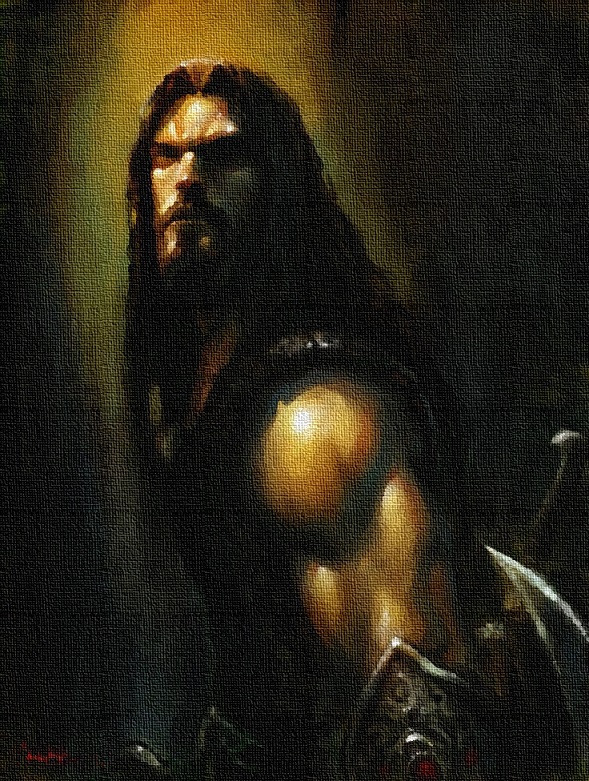Thrand: Difference between revisions
No edit summary |
No edit summary |
||
| Line 9: | Line 9: | ||
'''Behavior: ''' According to Baron John, Thrand was a member of a Norse blood-cult who called themselves ''einherjar'' and believed that they were descended from the Scandinavian gods. Thrand in many ways was a prime example of an ''einherjar'' warrior, stoic in the face of adversity, brave almost to a fault and cunning in battle. But his weaknesses could out weight his strengths in his obvious lack of subtly everywhere but on the battlefield. Despite his uncouth ways, Thrand was seen as a just and egalitarian ruler who largely ignored the distinctions between the Higher and Lower clans during his reign. Despite this he had a knack for making enemies and a startling lack of political acumen. | '''Behavior: ''' According to Baron John, Thrand was a member of a Norse blood-cult who called themselves ''einherjar'' and believed that they were descended from the Scandinavian gods. Thrand in many ways was a prime example of an ''einherjar'' warrior, stoic in the face of adversity, brave almost to a fault and cunning in battle. But his weaknesses could out weight his strengths in his obvious lack of subtly everywhere but on the battlefield. Despite his uncouth ways, Thrand was seen as a just and egalitarian ruler who largely ignored the distinctions between the Higher and Lower clans during his reign. Despite this he had a knack for making enemies and a startling lack of political acumen. | ||
'''History: ''' | '''History: ''' Before the year 866 A.D., nothing can be gleaned of Thrand's mortal history. But in that year the Vikings took advantage of local internecine struggles to launch a successful raid on York. The oral histories of John de York suggest that the ancient Roman Ventrue ruler of York engineered the Viking raid on York as a counter measure to weaken and drive out unspecified rivals whose mortal minions were becoming a threat to Julian's base of power. Regardless of why the Vikings raided and captured York, Julian chose Thrand as his next childe shortly after the city was taken. Over the next fifty years, as York slowly transformed into Jórvík, Thrand served as Julian's war-master and chief bodyguard. That is until the year 920, when for reasons unknown to John de York, Thrand betrayed and expelled his sire to the south of England. In that same year he created a childe [[Katla Thranddottir]] and raised her to be his seneschal, but Thrand's reign was only to last until 1066 when the Normans invaded England under the leadership of William the Conqueror. | ||
'''Rest in Peace: ''' | '''Rest in Peace: ''' In autumn of 1066, Julian returned after a century of absence with a large brood of childer and an army of Normans to help him exact his revenge and recapture his city. Thrand died fighting his sire's new brood while his sire watched from the shadows. | ||
Revision as of 09:28, 3 January 2016
Appearance: Even accounting for the growth of tales told over time, Thrand must have been a mountain of a man. All the tales point to his standing a head and shoulders above his own men and the Saxon population of York equally. Baron John's grudging recollections paint a romantic picture of a musclebound Scandinavian giant with the face of an angry god and a mane of dark auburn hair to his waist. According to John he always wore a hauberk of steel chain over a simple jerkin of oiled oxhide and never bothered to adapt to the local Saxon fashions. Regardless of the circumstances, Thrand always kept his great-axe and a bejeweled shield within easy reach and never failed to use both regularly.
Behavior: According to Baron John, Thrand was a member of a Norse blood-cult who called themselves einherjar and believed that they were descended from the Scandinavian gods. Thrand in many ways was a prime example of an einherjar warrior, stoic in the face of adversity, brave almost to a fault and cunning in battle. But his weaknesses could out weight his strengths in his obvious lack of subtly everywhere but on the battlefield. Despite his uncouth ways, Thrand was seen as a just and egalitarian ruler who largely ignored the distinctions between the Higher and Lower clans during his reign. Despite this he had a knack for making enemies and a startling lack of political acumen.
History: Before the year 866 A.D., nothing can be gleaned of Thrand's mortal history. But in that year the Vikings took advantage of local internecine struggles to launch a successful raid on York. The oral histories of John de York suggest that the ancient Roman Ventrue ruler of York engineered the Viking raid on York as a counter measure to weaken and drive out unspecified rivals whose mortal minions were becoming a threat to Julian's base of power. Regardless of why the Vikings raided and captured York, Julian chose Thrand as his next childe shortly after the city was taken. Over the next fifty years, as York slowly transformed into Jórvík, Thrand served as Julian's war-master and chief bodyguard. That is until the year 920, when for reasons unknown to John de York, Thrand betrayed and expelled his sire to the south of England. In that same year he created a childe Katla Thranddottir and raised her to be his seneschal, but Thrand's reign was only to last until 1066 when the Normans invaded England under the leadership of William the Conqueror.
Rest in Peace: In autumn of 1066, Julian returned after a century of absence with a large brood of childer and an army of Normans to help him exact his revenge and recapture his city. Thrand died fighting his sire's new brood while his sire watched from the shadows.
